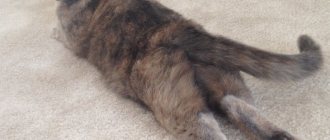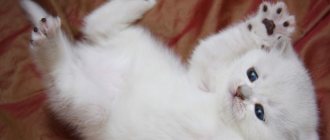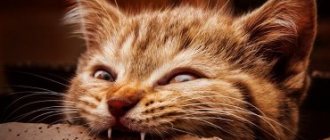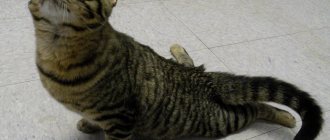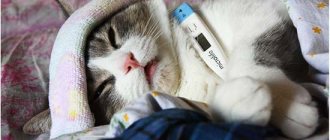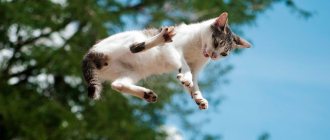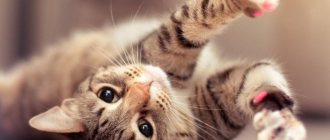Does the cat arch its back? Does she suddenly start running like crazy, as fast as she can, circling the room, jumping over couches or up and down the stairs, with her fur standing on end? It's very funny and interesting to watch, and at the same time scary, because she might bump into something and hurt herself. But she seems to be having a great time. Is it harmless fun or a cause for concern?
Most cats exhibit this behavior. Cat adventures, also known as periods of frantic random activity, are a normal and fun activity for them, although it can drive you crazy if they happen at 2 am.
When does this happen?
It comes out of nowhere. Sometimes the cat seems to “see” something invisible and starts running, or it may be in a playful mood, which may be aggravated by play. Cats also practice their stalking, hunting, and chasing behaviors, and this can cause them to arch their backs. There can be many reasons for this. After all, running is fun!
Kittens and young cats are more likely to fall into this state as they are full of energy and this can be a way of burning off excess energy. But sometimes even older cats can arch their back. Cats sleep most of the day when their owners are at work, so when they return home, the animals are awake and full of pent-up energy.
Causes
Cats find themselves in a variety of situations throughout the day. They might run into a rival kitty on the block or get a pet from their loved one. All of these interactions require different responses. So let's dive into why cats may arch their backs and what it means.
© shutterstock
- After a good night's sleep, the cat arches its back to stretch its muscles . It activates all the muscles that were inactive due to sleep. Cats are much more flexible than people.
- When a cat feels threatened by anything , any person or any other animal, they will begin to arch their back to show that they are in attack mode. When a cat feels threatened, its fur begins to stand out specifically on its tail. Cats do this because it makes them look larger and more aggressive. She may even begin to show her side profile, displaying more aggressive body language to ward off a threat, be it a thing, person, or animal. When your cat arches his back, raising his fur, and begins to grind his teeth, hissing at something or someone, he is afraid of that object or person and wants it to go away.
- But cats also arch their backs when they are playing or having fun . But this time they won't growl or hiss. Instead, they will start jumping and lashing out at someone they are comfortable with or feel safe with.
- Cats are very sensitive creatures, so tail lifting and arching can be caused by hormones , muscle strain, or misfortune. Sometimes they get angry when someone invades their territory. Pain is another real factor that causes cats to arch their backs.
- But when a cat feels happy and content, she begins to arch her back . When you pet a cat and it feels good, it will begin to arch its back and sometimes come closer to you, purring. This is their body language to let you know that they are happy and content with your company.
- When you pet your cat, she may think it's time to eat . Some young cats believe that petting is a sign that their owner is about to feed them. Some cats love to eat after being petted. For the same reason, they begin to arch their back.
- When a cat is in pain, it will often begin to arch its back . If your cat arches her back for reasons related to pain, she will do this constantly. Whenever she feels pain, she reflexively begins to arch her back. Other causes of back arching are not permanent, but pain-related causes are permanent.
Should I worry?
Your cat may need more exercise. Set aside time every day to play with her and provide her with toys and puzzles filled with food. Change her toys to new ones periodically so that she doesn't get bored with them.
There are medical reasons why a cat may begin to exhibit this behavior. If an older or lazy cat suddenly becomes abnormally active and restless or behaves strangely, your veterinarian may want to check for any health problems such as feline hyperthyroidism (an overactive thyroid gland).
Older cats suffering from cognitive dysfunction syndrome or dementia may also begin to run around uncharacteristically. Cats that are experiencing physical changes, such as vision or hearing loss, may also begin to arch their back, and if this is a strange behavior for your pet, a visit to the vet is recommended.
Behavioral problems may be related to anxiety or stress, where the cat may become hypersensitive to stimuli in its environment and react by running uncharacteristically. Even flea or insect bites can cause her to arch her back to relieve irritation or severe itching, so check her coat for parasites.
If your cat shows any sudden changes in behavior, it is recommended that you take him to the vet to rule out any medical problems. If her behavior seems unpleasant and there is no medical explanation, seek help from a qualified cat behaviorist.
How to get a cat to stop this behavior?
Now, listen carefully, we eat, sleep and do what comes naturally to us. Arching the back is natural for cats. This is their way of protecting themselves as well as being playful. Under no circumstances should you suppress natural urges. It's not good for them. If you love your cat, just let her behave naturally. If you try to get her to stop arching back, she may become aggressive towards you. She may attack you.
When a cat is scared, it will naturally arch its back, showing its aggressive side, because it makes it look a little bigger, fiercer, and meaner. This often scares away their potential enemy. So this behavior is a lifesaver for them.
And when they play with you, they arch their back to show that they want to be with you, isn't it such a nice feeling when your pet loves you back? He will start pouncing and jumping on you and this will make you more joyful when you see your cat being playful and happy. She will listen to you in this mood because she is saying that she loves your company.
In my personal experience, try to keep your surroundings as calm and pleasant as possible. As a result, he will not become aggressive and, as a natural result, he will not arch his back while being completely protected.
How to remove mats from a cat at home
The owner can tidy up the pet's fur on his own. To remove a small amount of tangles you will need:
- product for home or professional cat hair care;
- comb with sparse and non-sharp teeth;
- tangle cutter (there are different types);
- a brush or a special glove for combing.
Particular attention should be paid to the choice of products that make it easier to comb the coat. They must be hypoallergenic, suitable for a certain type of wool, and have a high-quality composition. For example, the Elite spray conditioner from the Elite Professional series with allantoin, glycerin and a complex of conditioning components is suitable. It is adapted for home use, has an antistatic effect to reduce electricity, a softening and moisturizing effect, adds shine to the animal's coat, facilitates combing and prevents tangling.
Before purchasing cosmetics and grooming tools, you should consult a specialist in the field of cat grooming.
Steps to remove tangles:
- Spray the spray onto dry hair to make combing easier.
- Gently untangle the tangles with a wide-tooth comb. If this is not possible, you need to cut off the tangles with a special tool or nail scissors with thin rounded blades.
- Gently comb the fur with a brush.
In particularly advanced cases, if the cat is aggressive and restless, it is advisable to carry out the procedure together. One person holds the pet, the second removes tangles. This will avoid injury to the animal’s skin and protect the owner from scratches. After the procedure, you should treat the cat with a treat.
If you can’t deal with your cat’s tangles on your own, it’s better to go to a grooming salon. Specialists will help you put the fur in order, if necessary, give the animal a haircut and give recommendations on proper care. A hygienic clipper cut can be done under general sedation in a veterinary clinic.
Spray conditioner "Elite" of the Elite Professional series can be used not only on dry hair, but also after washing the cat on a slightly dry coat to make combing easier. For bathing, you can choose shampoo and balm “Elite” that are suitable for your coat type - professional products for regular care. After rinsing, you need to dry the coat a little, apply conditioner spray and comb it.
Preventing the appearance of mats in cats
It is easier to prevent tangles from appearing than to untangle and comb them out later. To do this, it is important to follow the following rules.
Health monitoring
It is recommended to regularly examine the cat at home, for example while brushing or playing, and to have a medical examination with a veterinarian 1–2 times a year. At the first signs of illness or the presence of alarming symptoms, the animal should be taken to the veterinarian as soon as possible.
Balanced diet
Proper nutrition, taking into account the daily need for nutrients, vitamins and minerals, taking, if necessary and only on the recommendation of a doctor, complex vitamin-mineral preparations, fatty acid complexes, and having clean water available at all times are some of the main conditions that have a beneficial effect on the beauty of the coat. pet.
Careful proper care
It includes combing and periodic washing using special shampoos selected taking into account the type of animal's coat, as well as additional cosmetics to facilitate combing. In addition, it is important to prevent the air in the room where the pet lives from drying out.
For daily combing of fluffy cats, you will need combs with sparse, non-sharp teeth and special brushes. It is better to carry out the procedure in several stages so as not to cause fatigue and irritation to the animal. When combing, special attention is paid to the armpits, belly, tail, and areas behind the ears. It is necessary to accustom a cat to such manipulations from an early age. In addition, daily brushing helps not only maintain the aesthetic appearance of the coat, but also strengthens the emotional connection between the owner and the cat, allowing you to show your pet your love and care.
What is ataxia?
Without going into details, this is the name for a set of symptoms that imply problems with coordination of movements and body position in space. There are three types of this pathology:
- Cerebellar ataxia in cats is caused by damage to the cerebellum.
- Accordingly, vestibular occurs in cases where something is very wrong with the vestibular apparatus located in the inner ear.
- Sensitive . In some ways it is similar to the cerebellar, only in this case important nerve cords are damaged.
There are different causes of ataxia in cats. Most often, the development of the disease is due to:
- Poisoning with various poisons.
- Hereditary diseases accompanied by degenerative phenomena in the nervous tissue.
- Injuries that occur especially often in March, when loving cats fall from balconies.
- Lack of vitamin B1. This is generally typical for cats: many owners “pamper” them with fresh river fish, which contains the enzyme thiaminase. It destroys thiamine, that is, B1, resulting in ataxia. This is especially noticeable in kittens.
- If the cat is “hooked” on some plants. For example, a large dose of catnip can send a cat into “nirvana” for several minutes. At this time, the pet looks like an inveterate drunkard.
- Traumatic brain injury.
- Tumor.
- Infection. In particular, feline panleukopenia is very dangerous.
- Hydrocephalus or cerebral edema.
Injuries or impairments
Photo: Hronika
It also happens that cats prefer not to put weight on their front paws solely because it is painful. Fractures, deformations, arthritis of the front legs, and other congenital and acquired anomalies - all this leads to the fact that the animal has to learn the least traumatic gait - on the hind legs. And in the case of traumatic amputation or congenital absence of limbs, in principle there is no alternative to such a gait.
We also think you might be interested to know why cats love to sleep on their owners. There are plenty of reasons for this too.
Symptoms and diagnosis
In general, the symptoms of ataxia in cats are simple. The pet looks like a drunkard, he shakes, the cat cannot walk normally, in severe cases he falls on his side with a roar, just trying to sit down. A constant tilt of the head to one side, as well as erratic circular eye movements, are very typical. Other symptoms may vary depending on the underlying cause of the ataxia. For example, a cat “under mint” can walk with a wobbling gait with its head held high; from time to time, it shakes it and generously splashes saliva around. It looks terrible, but goes away quickly.
Your veterinarian will perform a complete physical examination of your cat. The information provided by the cat's owner is important. It is advisable to remember the following:
- Did the animal have access to household chemicals, poisons, or was deratization (rodent extermination) carried out in your home or area?
- Is there any information in your pet’s pedigree about any pathologies that the cat’s parents suffered from?
- Did the cat fall from the balcony, did it get hit by a bicycle, etc.
Inspection of the territory
Photo: Lockerdome
When a cat can climb something high, he does it. When he can’t, in order to be aware of what’s happening around him, he has to stand on his hind legs. This somehow increases the field of view, especially if there is thick and tall grass around. The Joinfo.com team and journalist Artem Kostin remind us that many animals do this in the wild, for example meerkats.
